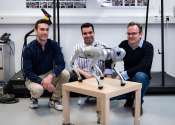Versatile, portable exosuit assists with both walking and running
Between walking at a leisurely pace and running for your life, human gaits can cover a wide range of speeds. Typically, we choose the gait that allows us to consume the least amount of energy at a given speed. For example, ...
Aug 15, 2019
0
154









